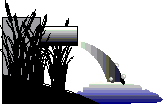Sanitary and Storm Sewers
One drain is about like another, right? The sewer is the sewer, right? Anything poured down a drain goes to a wastewater treatment plant, right? WRONG! It's important to understand the difference between sanitary sewers and storm sewers so we can prevent unnecessary environmental damage and help the University comply with its wastewater permits.
The sanitary sewer is a system of underground pipes that carries sewage from bathrooms, sinks, kitchens, and other plumbing components to the wastewater treatment plant. Wastewater from UK leaves the campus through one of ten discharge points that connect to the city sewer system and are monitored by the local sanitary sewer authority.
The storm sewer is a system designed to carry rainfall runoff and other drainage but not sewage. The runoff is carried in underground pipes or open ditches and discharges (untreated) into streams or other surface water bodies. The inlets to this system may be found in curbs and low-lying outdoor areas. Some older buildings have basement floor drains that connect to the storm sewer system.
Most of the drainage (both surface and subsurface) from UK is into Town Branch flowing out of Lexington to the west. Two major tributaries, Vaughns Branch and Wolf Run, have their headwaters near campus. Surface drainage is also collected in a series of sinkholes on and near campus, eventually draining toward McConnell Springs to the northwest of campus or to an unnamed spring along Town Branch. A relatively small area of campus (< 10%) lies within the West Hickman Creek drainage basin
Disposal of chemicals or hazardous substances via the storm sewer system is not only illegal but damages the environment. Pollutants that get into storm drains can poison fish, birds, and other wildlife, and can find their way into drinking water supplies. In addition, silt, litter, and organic matter (branches, clippings, etc.) can clog storm drains and cause flooding.
You can help! Try these simple measures:
|
|
|
|
|
|
|
|
| Don't dump any material into a drain unless you know where the drain goes and that it's OK to dispose of materials there. Many drains go directly to streams! |
 |  |
Send comments to D. Caskey